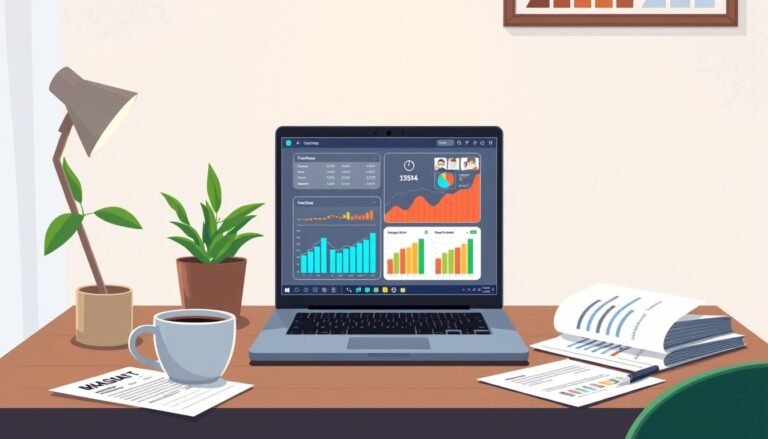Gig Economy: Financial Considerations
The gig economy has changed how we work. About 36% of the U.S. workforce now works in gigs. It’s important to know the financial ups and downs of this flexible career path.
Gig work brings freedom, but it also needs careful money planning. Unlike regular jobs, gig workers often have to manage many income sources. In fact, 36% of gig workers do this while keeping a full-time job. This requires a hands-on approach to handling finances.
Dealing with income that changes a lot is a big challenge for gig workers. Their earnings can go up and down from week to week or month to month. To stay financially stable, they need good budgeting plans. It’s key to plan for both good and bad money times.
Key Takeaways
- 36% of U.S. workers participate in the gig economy
- Income volatility is a common challenge for gig workers
- Effective budgeting strategies are crucial for financial stability
- Only 19% of gig workers have access to retirement benefits
- Gig work can provide opportunities for underrepresented groups
- Good credit management is important for gig workers
Understanding the Fundamentals of Gig Work
The gig economy has changed how we work and earn. With nearly 64 million Americans involved, it’s key to know its basics.
Types of Gig Economy Jobs
Gig work covers many areas, like ride-sharing and creative services. Freelance writers, graphic designers, and programmers often deal with contract negotiations and invoicing.
Key Characteristics of Gig Work
Gig work offers freedom and flexible hours. Workers like choosing projects and managing their time. But, it also brings challenges like covering personal costs and dealing with taxes.
Market Size and Growth Trends
The gig economy is booming, adding $1.27 trillion to the U.S. economy. Its growth is driven by digital platforms and changing work preferences.
| Aspect | Data |
|---|---|
| U.S. Gig Workers | 38% of workforce |
| Economic Contribution | $1.27 trillion |
| Cost Savings for Companies | 25-40% per employee |
While the gig economy offers chances, it has downsides. Gig workers often report lower mental health and life satisfaction. The lack of benefits and financial insecurity are big concerns.
“The gig economy provides flexibility but demands careful financial planning and self-management.”
Knowing these basics is crucial for those thinking about gig work or businesses wanting to tap into this growing workforce.
Income Management in the Gig Economy
Gig workers face unique financial challenges. Income volatility is a big issue, with 85% finding it hard to manage multiple income streams. This unpredictability requires smart budgeting strategies to stay afloat.
Dealing with Variable Income
To handle income fluctuations, 60% of gig workers use separate bank accounts for their earnings. This helps track finances and set aside money for lean periods. Creating an emergency fund is crucial, with 45% of self-employed individuals prioritizing this safety net.
Creating Income Streams
Diversifying revenue is key to financial stability in the gig economy. 75% of self-employed individuals focus on growing multiple income streams. This approach helps buffer against the loss of any single gig and provides more consistent overall earnings.
Setting Rates and Pricing Strategies
Effective pricing is essential for gig workers. The average hourly rate for independent workers in North America was $44 in 2022. When setting rates, consider market standards, personal financial goals, and the value of your skills. Remember to factor in taxes and expenses when pricing your services.
| Financial Strategy | Percentage of Gig Workers |
|---|---|
| Use accounting software/spreadsheets | 72% |
| Seek professional tax advice | 55% |
| Save for retirement independently | 40% |
By implementing these income management strategies, gig workers can navigate the financial complexities of the gig economy more effectively. Remember, success in this field requires both skill in your craft and savvy financial planning.
Gig Economy: Financial Considerations
Gig workers face unique financial challenges. A survey by the National Association of the Self-Employed found that 33% of respondents didn’t know about quarterly tax payments. This lack of knowledge can lead to costly mistakes.
Managing income is key in the gig economy. With irregular pay, budgeting is crucial. Unlike traditional employees, gig workers don’t have wage and hour laws to guide payment frequency.
Building an emergency fund is vital for gig workers. It acts as a safety net during lean times or unexpected expenses. Experts suggest saving 3-6 months of living expenses.
“The gig economy offers flexibility, but it comes with financial responsibilities. Planning is key.”
The COVID-19 pandemic increased gig work as people looked to supplement their income. This trend showed the importance of solid financial planning for gig workers.
| Financial Consideration | Percentage of Gig Workers |
|---|---|
| Unaware of quarterly tax payments | 33% |
| Not setting aside money for taxes | 40% |
| Facing job insecurity | 62% |
| Lacking traditional benefits | 78% |
Gig workers must carefully navigate these financial considerations. From tax planning to creating a stable income, understanding these aspects is crucial for success in the gig economy.
Tax Planning and Obligations
Gig workers face unique tax challenges. As independent contractors, they must plan and pay their own taxes. This includes managing quarterly payments, understanding what expenses they can deduct, and keeping detailed records.
Quarterly Tax Payments
Gig workers must make quarterly estimated tax payments. This covers income and self-employment taxes. The self-employment tax rate is 15.3%, with 12.4% for Social Security and 2.9% for Medicare.
Payments are due on April 15, June 15, September 15, and January 15. Not paying enough can lead to penalties.
Deductible Expenses
It’s important for gig workers to lower their taxable income by deducting expenses. They can deduct various business costs:
- Mileage
- Equipment
- Supplies
- Home office costs
- 50% of business meals
Record Keeping Requirements
Keeping accurate records is key for tax planning and invoicing. The IRS suggests keeping records for at least three years. However, the American Institute for Certified Public Accountants recommends seven years for full compliance.
| Document Type | Retention Period |
|---|---|
| Income Records | 7 years |
| Expense Receipts | 7 years |
| Bank Statements | 7 years |
| Tax Returns | 7 years |
By understanding tax obligations and keeping thorough records, gig workers can efficiently manage self-employment taxes.
Building a Financial Safety Net
Gig workers face unique financial challenges. They have irregular income and no traditional benefits. It’s crucial to build a strong financial safety net. Let’s explore key strategies to secure your financial future in the gig economy.
Emergency Fund Strategy
An emergency fund is your first line of defense against financial uncertainties. Aim to save three to six months of living expenses. Start small and build consistently.
Automate your savings by transferring a portion of each gig payment to a separate account. This habit ensures you’re prepared for slow periods or unexpected costs.
Insurance Coverage Options
Without employer-provided benefits, gig workers must secure their own insurance. Health insurance is a top priority. Explore individual plans or gig worker-specific health insurance options.
Don’t overlook disability and liability insurance. These protect you if you’re unable to work or face legal issues related to your gig work.
Credit Management
Good credit is vital in the gig economy. It provides a financial cushion during lean times and helps achieve long-term goals. Pay bills on time and keep credit card balances low.
If you’re struggling with debt, consider negotiating payment plans or seeking help from nonprofit credit counseling agencies.
| Financial Safety Net Component | Recommendation |
|---|---|
| Emergency Fund | 3-6 months of expenses |
| Health Insurance | Individual or gig-specific plans |
| Disability Insurance | 1-3% of annual income |
| Liability Insurance | Based on gig type and risk |
Building a financial safety net takes time and discipline. Start today by setting clear goals and taking small, consistent steps. Your future self will thank you for the financial security you’re creating now.
Retirement Planning for Gig Workers
Gig workers face unique challenges in retirement savings. With nearly 40% of Americans in the gig economy, it’s key to tackle these financial hurdles. Self-employed folks lack employer-sponsored plans, so they must act early for a secure future.
Gig workers have several retirement savings options. IRAs offer flexibility, with a $7,000 annual limit ($8,000 for those 50+). SEP IRAs let higher earners contribute up to 25% of their income or $69,000, whichever is less. Solo 401(k)s offer even more, with a $69,000 cap for both employee and employer contributions, plus an extra $7,500 for those 50+.
“Planning for retirement as a gig worker requires discipline and foresight. It’s not just about saving; it’s about creating a strategy that aligns with your unique income patterns and long-term goals.”
To plan for retirement, gig workers should save a consistent percentage of their income. This steady approach helps reach retirement goals. Also, getting advice from a financial planner can craft a strategy for gig work’s unpredictability.
| Retirement Plan | Annual Contribution Limit | Catch-up Contribution (Age 50+) |
|---|---|---|
| Traditional/Roth IRA | $7,000 | $1,000 |
| SEP IRA | $69,000 or 25% of income | N/A |
| Solo 401(k) | $69,000 | $7,500 |
| SIMPLE IRA | $16,000 | $3,500 |
By knowing these retirement options and planning well, gig workers can secure their financial future. This is despite the income’s variability.
Managing Business Expenses and Cash Flow
Gig workers face unique challenges in managing their finances. They have irregular income and multiple income streams. It’s crucial to stay on top of expenses and cash flow. Let’s explore some effective strategies for tackling these challenges.
Tracking Business Costs
Keeping tabs on business expenses is vital for gig workers. This includes equipment, transportation, and marketing costs. By tracking these expenses, you can better understand your profit margins and make informed decisions about your gigs.
Invoicing and Payment Systems
Prompt freelance invoicing is key to maintaining a healthy cash flow. Send invoices right after completing a gig and follow up on overdue payments. Using digital platforms can streamline this process, making it easier to keep your finances in order.
Budget Planning Tools
Implementing effective budgeting strategies is essential for gig workers. Consider using apps like QuickBooks or FreshBooks to track income and expenses. These tools can help you forecast your cash flow and plan for lean periods.
- Set aside 25-30% of income for taxes
- Create an emergency fund covering 3-6 months of expenses
- Diversify income sources across multiple platforms
- Conduct monthly financial reviews to assess gig profitability
By adopting these practices, gig workers can better manage their business expenses and maintain a steady cash flow. This is especially important when facing income volatility.
Benefits and Healthcare Considerations
Gig workers face unique challenges with health insurance and money matters. They often don’t get benefits from employers. So, they need to look for other ways to get covered.
Buying individual health insurance plans is a good choice for many gig workers. These plans are flexible and can be adjusted to fit your needs. Joining professional associations can also help, as they offer group rates that might be cheaper.
Health-sharing ministries are another option for gig workers. They let members share the cost of healthcare. But, they might not cover everything.
- Direct Primary Care (DPC): A subscription-based model offering predictable monthly fees for primary care services
- Level-Funded Health Plans: Provide stability and potential cost savings, aligning with fluctuating incomes
- Gig Economy-Specific Health Plans: Tailored options with flexible coverage and simplified enrollment processes
Gig workers should also think about disability insurance and liability coverage. These can protect them from unexpected events that might stop them from working or earning money.
“The gig economy workforce in the U.S. grew by 5 million individuals since 2012, with approximately 3% of the U.S. workforce being gig workers by 2021.”
New tech solutions are helping gig workers find the right health insurance. These platforms use algorithms to suggest plans that fit their needs, making it easier to choose.
When picking health insurance, gig workers need to weigh the cost against what’s covered. They should think about things like pre-existing conditions, the doctors they can see, and how much money they make. This helps them make smart choices about their money.
Conclusion
The gig economy has changed the way we work, offering flexible jobs and new ways to earn. It requires smart financial planning and good management skills. By facing its challenges and using its opportunities, people can build lasting and fulfilling careers.
To succeed in the gig economy, it’s important to have a few key strategies. First, diversify your income to reduce risks. Keep a tight budget and focus on long-term financial health. Gig workers also need to handle taxes well, save for emergencies, and plan for retirement.
The gig economy is growing, thanks to new tech and changing work habits. Workers and employers must keep up. Stay updated on trends, improve your skills, and follow good financial advice. The gig economy can lead to financial freedom and job happiness for those who are smart and forward-thinking.
Source Links
- Managing Money in the Gig Economy – Hands on Banking
- The Gig Economy: Impact and Implications for Financial Markets
- Gig Economy
- What Is a Gig Economy?
- The Gig Economy and Finances: Managing Income Streams | FSB Blog
- The Gig Economy and Personal Finance: Managing Finances in a Non-Traditional Work Setting – InvestaDaily
- The Gig Economy: Shaping the Future of Work and Business | Park University
- Implications of Participating in the Gig Economy
- What Is the Gig Economy?
- Navigating Taxes in the Gig Economy
- Tax considerations for the gig economy | Taxing Matters
- Tax Implications of Gig Economy Work: Navigating the Financial Landscape
- Can You Build Financial Security in the Gig Economy?
- How can you create a financial safety net while working in the gig economy?
- Financial Freedom In The Gig Economy: Tips For Managing Debt & Irregular Income
- Retirement plan options for the self-employed
- Encouraging Retirement Saving in the Gig Economy — Ascensus
- Cash Flow Per Service: Understanding Cash Flow Per Service in the Gig Economy – FasterCapital
- Navigating the Gig Economy: Financial Tips for Success
- Navigating the Numbers: Overcoming Accounting Challenges in the Gig Economy – Accounting for Everyone
- The Gig Economy Worker: A New Social Determinant of Health?
- How should we provide benefits to gig workers?
- Bridging the Benefits Gap: Innovative Health Insurance Solutions for the Gig Economy | Decent
- The Gig Economy and Its Implications for Hiring
- The Rise of the Gig Economy: Pros and Cons for Workers and Employers – IT Supply Chain








